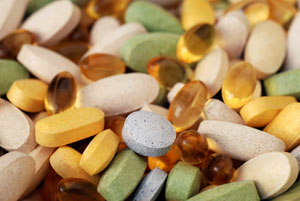In the metric system:
1000 milligrams (mg) is a unit of mass that equals to 1 gram
1000 micrograms (mcg) is equal to 1 milligram (mg).
An IU (International Unit) is a unit of measurement for vitamins and other specific biologically active substances.
Article Category: Units |
One of the most common conversion enquiries from visitors to this website is regarding how to convert between International units (iu) and micrograms (mcg) and milligrams (mg). Commonly, people want to work out the amount of micrograms or milligrams in a medication or vitamin supplement.
I think that people wonder why the International unit isn't in the lists featured in the mass and weight converter. The reason for this is that the conversion isn't as simple as one might think. Let's start this article by discussing what an International unit is.
What is an International unit?
IU stands for International units and is a unit commonly used in the measurement of medications, vaccines and vitamins.
The volume or mass that makes up one International unit is dependent on the concentration or potency of the substance and therefore varies from substance to substance depending on what is being measured.
This means that converting between international units and micrograms or milligrams is not a simple calculation and we can't provide a converter to do this calculation for you (sorry about that). The exact measure of one IU of a substance is in fact established by international agreement for each substance 1.
How to find out the conversion value?
If you want to find out how many micrograms (mcg) or milligrams (mg) are in one IU of your medication, you could contact your pharmacist to find out. As an alternative, you could try contacting the drug manufacturer directly. For a vitamin, consider contacting the vitamin manufacturer - their contact information is usually listed on the bottle.
Converting from mg or mcg to IU for Vitamins A, C, D and E
- Vitamin A: 1 IU is the biological equivalent of 0.3 mcg retinol, or of 0.6 mcg beta-carotene
- Vitamin C: 1 IU is 50 mcg L-ascorbic acid
- Vitamin D: 1 IU is the biological equivalent of 0.025 mcg cholecalciferol or ergocalciferol
- Vitamin E: 1 IU is the biological equivalent of about 0.67 mg d-alpha-tocopherol, or 0.9 mg of dl-alpha-tocopherol.
Example conversion
Let's say that I have a soft gel capsule that contains 500 IU of Vitamin A as retinol. To convert this to mcg, using the information above, I would multiply it by 0.3:
500 × 0.3 = 150mcg.
Conversely, if the soft gel capsule was described as '150mcg of Vitamin A as retinol' and I wanted to convert to IU, I would divide it by 0.3.
150 ÷ 0.3 = 500 IU.
Note that the information contained here is purely for casual interests and is not intended to replace your doctor's advice. Please use it at your own risk.
As with all calculations where health could suffer from inaccurate conversions, you are advised to check with a health professional before taking a dosage of any vitamin or supplement.
Yes! It is fine to take Supplements and Vitamins with Alkaline Water as it will enhance the potency of the ingredients for an over-all healthy system. However; it is also recommended, for those on medication, to take the supplement/vitamin 60 up to 120 minutes. This is due to allow the medication (most are time released) to properly work in the body for it's designed purpose.
Stay tune next week for more articles pertaining to Today's world of Health and Wellness.
Ms J from Fuquay
919 614 4569
JFerrell.4569@gmail.com
"An ounce of prevention is worth a pound of cure!" Ben Franklin

